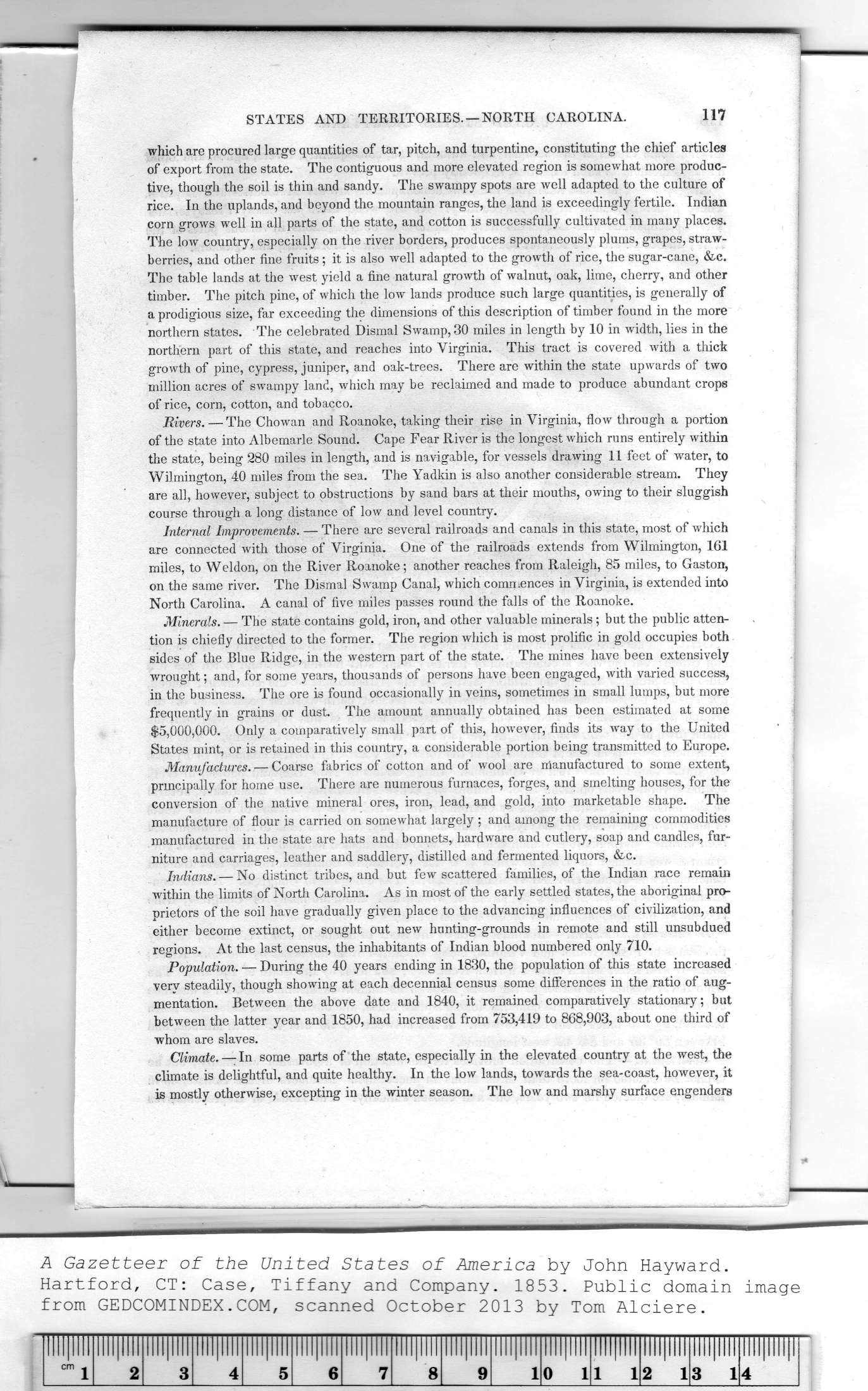|
|
Note: Ctrl and + increases the font size of the text below, Ctrl and - decreases it, and Ctrl and 0 resets it to default size.
STATES AND TERRITORIES. — NORTH CAROLINA. 117
which are procured large quantities of tar, pitch, and turpentine, constituting the chief articles
of export from the state. The contiguous and more elevated region is somewhat more produc-
tive, though the soil is thin and sandy. The swampy spots are well adapted to the culture of
rice. In the uplands, and beyond the mountain ranges, the land is exceedingly fertile. Indian
corn grows well in all parts of the state, and cotton is successfully cultivated in many places.
The low country, especially on the river borders, produces spontaneously plums, grapes, straw-
berries, and other fine fruits ; it is also well adapted to the growth of rice, the sugar-cane, &e.
The table lands at the west yield a fine natural growth of walnut, oak, lime, cherry, and other
timber. The pitch pine, of which the low lands produce such large quantities, is generally of
a prodigious size, far exceeding the dimensions of this description of timber found in the more
northern states. The celebrated Dismal Swamp, 30 miles in length by 10 in width, lies in the
northern part of this state, and reaches into Virginia. This tract is covered with a thick
growth of pine, cypress, juniper, and oak-trees. There are within the state upwards of two
million acres of swampy land, which may be reclaimed and made to produce abundant crops
of rice, corn, cotton, and tobacco.
Rivers. — The Chowan and Roanoke, taking their rise in Virginia, flow through a portion
of the state into Albemarle Sound. Cape Fear River is the longest which runs entirely within
the state, being 280 miles in length, and is navigable, for vessels drawing 11 feet of water, to
Wilmington, 40 miles from the sea. The Yadkin is also another considerable stream. They
are all, however, subject to obstructions by sand bars at their mouths, owing to their sluggish
course through a long distance of low and level country.
Internal Improvements. — There are several railroads and canals in this state, most of which
are connected with those of Virginia. One of the railroads extends from Wilmington, 161
miles, to Weldon, on the River Roanoke; another reaches from Raleigh, 85 miles, to Gaston,
on the same river. The Dismal Swamp Canal, which commences in Virginia, is extended into
North Carolina. A canal of five miles passes round the falls of the Roanoke.
Minerals. — The state contains gold, iron, and other valuable minerals ; but the public atten-
tion is chiefly directed to the former. The region which is most prolific in gold occupies both
sides of the Blue Ridge, in the western part of the state. The mines have been extensively
wrought; and, for some years, thousands of persons have been engaged, with varied success,
in the business. The ore is found occasionally in veins, sometimes in small lumps, but more
frequently in grains or dust. The amount annually obtained has been estimated at some
$5,000,000. Only a comparatively small part of this, however, finds its way to the United
States mint, or is retained in this country, a considerable portion being transmitted to Europe.
Manufactures. — Coarse fabrics of cotton and of wool are manufactured to some extent,
principally for home use. There are numerous furnaces, forges, and smelting houses, for the
conversion of the native mineral ores, iron, lead, and gold, into marketable shape. The
manufacture of flour is carried on somewhat largely ; and among the remaining commodities
manufactured in the state are hats and bonnets, hardware and cutlery, soap and candles, fur-
niture and carriages, leather and saddlery, distilled and fermented liquors, &c.
Indians. — No distinct tribes, and but few scattered families, of the Indian race remain
within the limits of North Carolina. As in most of the early settled states, the aboriginal pro-
prietors of the soil have gradually given place to the advancing influences of civilization, and
either become extinct, or sought out new hunting-grounds in remote and still unsubdued
regions. At the last census, the inhabitants of Indian blood numbered only 710.
Population. — During the 40 years ending in 1830, the population of this state increased
verv steadily, though showing at each decennial census some differences in the ratio of aug-
mentation. Between the above date and 1840, it remained comparatively stationary; but
between the latter year and 1850, had increased from 753,419 to 868,903, about one third of
whom are slaves.
Climate. — In some parts of the state, especially in the elevated country at the west, the
climate is delightful, and quite healthy. In the low lands, towards the sea-coast, however, it
is mostly otherwise, excepting in the winter season. The low and marshy surface engenders
|
lllllllll |
lllllllll |
lllllllll |
lllllllll |
llll|llll |
lllllllll |
llllfllipilllll |
lllllllll |
lllllllll |
lllllllll |
nfiiipiiipiii |
lllllllll |
|
|
|
2 |
3 |
4 |
5 |
6 |
00 |
9 |
1 |
0 1 |
1 12 1 |
3 1 |
4 |
|
